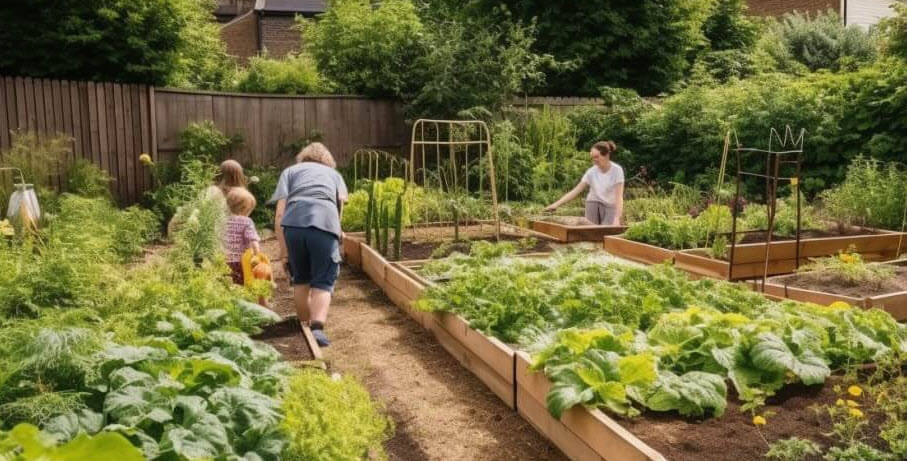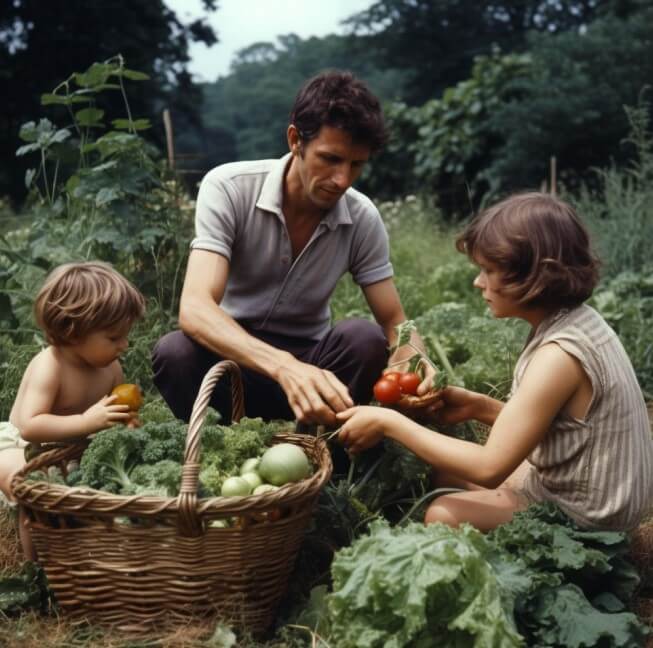Table of Contents
Introduction
Welcome to our comprehensive guide on designing and creating a captivating children’s veg plot! At [our company name], we understand the importance of fostering a love for gardening and nature in young minds. This article aims to provide you with practical tips, creative ideas, and expert insights to help you create a children’s allotment that stands out and captivates both kids and parents alike.
The Benefits of a Children’s Allotment
Making space for a childrens veg plot offers numerous benefits for children, from enhancing their physical and mental well-being to fostering a deeper connection with nature. A dedicated children’s veg patch takes these benefits a step further by providing a space where kids can actively engage in gardening activities tailored to their interests and abilities.
Planning and Designing Your Children’s Veg Plot
Choosing the Right Location
Selecting the perfect location for your children’s veg plot is crucial for its success. Look for an area that receives ample sunlight throughout the day, as most plants thrive in direct sunlight. Additionally, consider proximity to a water source to ensure easy irrigation.
Plot Layout and Size
When it comes to the layout and size of the veg plot, think about creating an engaging and accessible space. Aim for a size that is manageable for young gardeners, ensuring they can reach all areas comfortably. Dividing the plot into smaller sections or raised beds can provide a sense of structure and organization.
Creating a Child-Friendly Environment
Make the veg plot space welcoming and enticing for children by incorporating elements that appeal to their senses. Colourful flowers, whimsical garden decorations, and enticing pathways can add an element of wonder and imagination. Additionally, consider including child-sized tools and comfortable seating areas where kids can take breaks or observe their plants’ growth.
Selecting Plants for the Children’s Allotment
Choosing the right plants is key to maintaining children’s interest and enthusiasm. Opt for a mix of plants that are easy to grow, visually appealing, and offer sensory experiences. Here are a few popular plant choices for children’s veg plots:
1. Vibrant Flowers
Colourful flowers like sunflowers, marigolds, and pansies add a touch of beauty and attract beneficial insects. Encourage children to observe the different flower shapes, sizes, and colours while learning about pollination and the role of bees and butterflies in the garden ecosystem.
2. Tasty Vegetables and Herbs
Selecting vegetables and herbs that children can taste and use in their meals is an excellent way to engage their interest. Easy-to-grow options include cherry tomatoes, carrots, lettuce, basil, and mint. Involve children in the process of sowing seeds, caring for the plants, and eventually harvesting the delicious produce.
3. Fun and Unusual Plants
Introduce unique and fascinating plants to spark children’s curiosity. Consider including intriguing herbs like lemon balm with its pleasant scent, or “touch-me-not” plants that react to touch, and so on.
Engaging Activities for Young Gardeners
To keep children actively involved and excited about their veg plot, incorporate engaging activities into their gardening experience. Here are some ideas to inspire you:
1. Nature Scavenger Hunts
Create scavenger hunts that encourage children to explore their surroundings and discover the diverse flora and fauna. Include tasks like finding specific leaves, identifying bird calls, or spotting different insects. These activities promote learning, observation skills, and appreciation for the environment.
2. Garden Journaling
Encourage children to keep a garden journal where they can record their observations, draw pictures, and write about their gardening experiences. This activity nurtures their creativity, improves writing skills, and serves as a documentation of their progress and achievements. They can also use the journal to note down any questions or curiosities they have, which can lead to further exploration and learning.
3. Garden Crafts and DIY Projects
Integrate arts and crafts into the children’s allotment experience to unleash their creativity. Activities like making plant markers from recycled materials, designing and painting garden signs, or creating pressed flower art can add a personal touch to their space while encouraging their artistic abilities.
4. Garden Storytime
Set up a cosy reading nook in the allotment area where children can enjoy garden-themed books and stories. This provides a peaceful and educational break from gardening activities, allowing them to expand their knowledge about plants, insects, and the natural world.
Caring for the Children’s Veg Plot
Teaching children about the importance of proper care and maintenance is vital to the success of their veg plot. Here are some essential tasks to involve them in:
1. Watering and Irrigation
Demonstrate the significance of watering plants regularly and correctly. Show children how to check the soil’s moisture level and explain the importance of providing the right amount of water to different plants. Teach them how to use watering cans or gentle hoses to avoid damaging delicate seedlings.
2. Weeding and Pest Control
Explain the concept of weeds and their impact on plant growth. Engage children in the process of identifying and removing weeds to maintain a healthy garden. Teach them about natural pest control methods, such as companion planting or introducing beneficial insects, to protect plants without relying on harmful chemicals.
3. Mulching and Composting
Teach children about the benefits of mulching and composting. Explain how mulch helps retain soil moisture, suppress weeds, and provide essential nutrients to plants. Involve them in the process of creating compost from kitchen scraps, garden waste, and fallen leaves, emphasizing the importance of recycling and sustainability.
Remember, the journey of creating a children’s veg plot is an ongoing process filled with learning opportunities and joyful discoveries. Enjoy every moment of this rewarding experience and cherish the memories you create together in your thriving garden.
The Importance of Games in a Children’s Allotment
Integrating games into the children’s veg plot experience offers a multitude of benefits. Not only do they make gardening more enjoyable, but they also promote various skills and knowledge. Games encourage active participation, enhance problem-solving abilities, nurture teamwork and cooperation, and deepen children’s understanding of plants, insects, and the environment.
Fun and Educational Games for the Children’s Veg Plot
1. Plant Bingo
Create a customized Plant Bingo game that introduces children to a variety of plants in the allotment. Prepare bingo cards with different plant names or pictures. As children explore the garden, they can mark off the corresponding plants on their cards. This game promotes plant identification, observation skills, and vocabulary development.
2. Bug Hunt
Engage children in a thrilling Bug Hunt adventure to discover the fascinating world of insects in the allotment. Provide them with magnifying glasses, bug jars, and identification guides. Encourage them to search for different insects, observe their behaviours, and learn about their roles in the garden ecosystem. This game fosters curiosity, observation skills, and appreciation for nature’s tiny creatures.
3. Seed Sorting Race
Organize a friendly Seed Sorting Race where children compete to sort and categorize different seeds accurately and efficiently. Prepare a variety of seeds with distinct sizes and shapes. Provide containers and labels for different seed categories. The first child or team to sort the seeds correctly wins the race. This game enhances fine motor skills, categorization abilities, and familiarity with various plant species.
Make sure to use big seeds that they are able to handle, i.e., sunflowers, pumpkins, beetroot, broad beans, onion sets, peas, squashes, sweetcorn, bell peppers, garlic cloves, small potatoes, etc.
4. Garden Scavenger Hunt
Create an exciting Garden Scavenger Hunt that takes children on a quest to explore and discover specific features, plants, or objects in the allotment. Design a list of items or tasks for children to find, such as “Find a yellow flower,” “Identify three different types of leaves,” or “Collect a smooth pebble.” This game encourages observation, problem-solving, and critical thinking skills.
5. Plant Pictionary
Unleash children’s creativity and artistic skills with a lively game of Plant Pictionary. Prepare a set of plant-related words or phrases and write each on a small piece of paper. Divide children into teams. One person from each team selects a paper and silently draws the word or phrase on a whiteboard or large paper. Their team members must guess the plant based on the drawing. This game promotes artistic expression, vocabulary expansion, and teamwork.
6. Garden Trivia Challenge
Test children’s knowledge about gardening, plants, and nature with an exciting Garden Trivia Challenge. Prepare a list of questions of varying difficulty levels. Divide children into teams or play individually. Ask the questions and award points for correct answers. This game encourages learning, retention of information, and friendly competition.
7. Harvest Relay Race
Organize a Harvest Relay Race where children work together to complete gardening tasks quickly and efficiently. Create a course with designated stations, each representing a different task such as weeding, watering, or harvesting. Divide children into teams, and they take turns completing the tasks before passing the baton to the next team member. The first team to finish the race wins. This game promotes teamwork, time management, and physical activity.
Conclusion
Incorporating fun and educational games into the children’s veg plot experience not only adds an element of excitement but also enhances their learning and engagement with the garden. By implementing these interactive games, you can create a dynamic and enriching environment that encourages exploration, curiosity, and a deeper connection with nature.
Remember to adapt the games to suit the age group and abilities of the children involved. You can also modify the games based on the specific plants, insects, or topics you want to emphasize in your allotment. Don’t forget to provide clear instructions, promote teamwork and collaboration, and offer small rewards or incentives to make the games even more enjoyable.
As you introduce these games into your children’s allotment, you’ll witness their enthusiasm and passion for gardening flourish. They will develop essential life skills, such as problem-solving, observation, communication, and teamwork, all while immersing themselves in the wonders of the natural world.
So, get ready to embark on a journey of playful learning in your children’s veg plot. Implement these fun and educational games, and watch as your young gardeners thrive, gaining knowledge, and creating cherished memories that will last a lifetime.
If you need any further information or assistance with this article, don’t hesitate to Contact Us






















